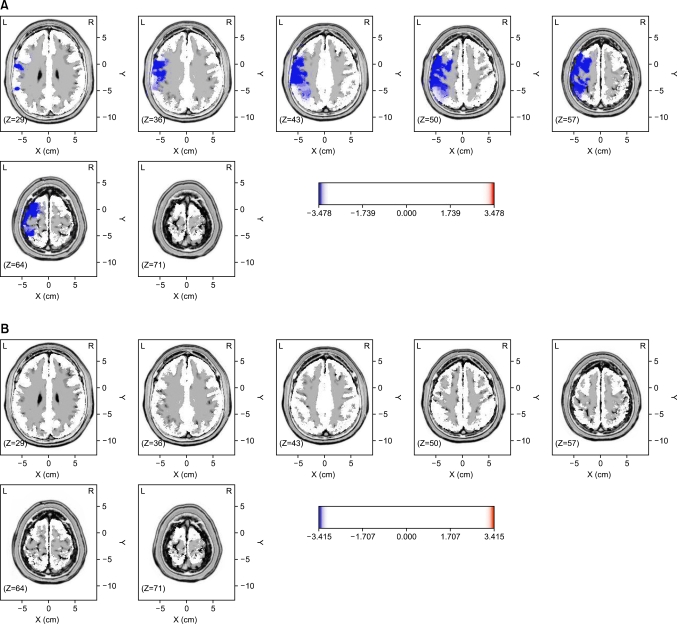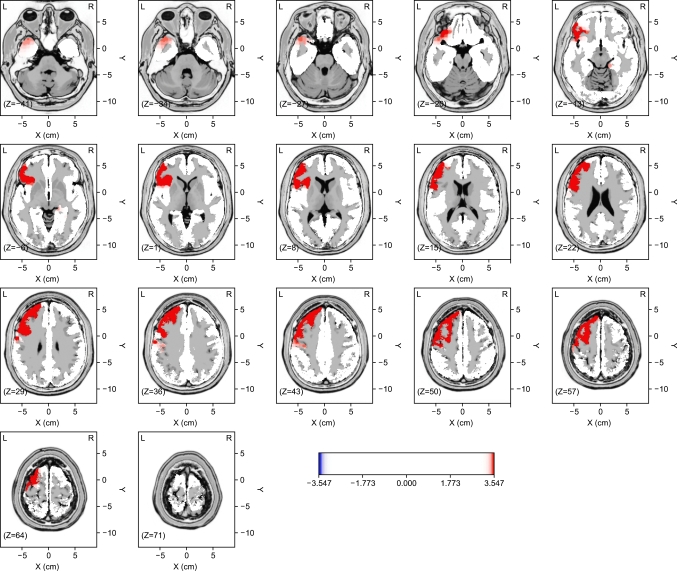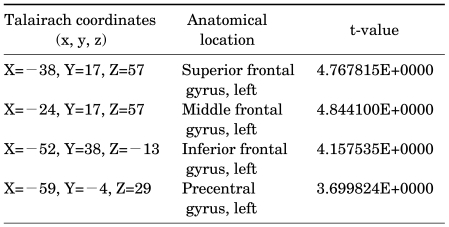1. McMahon CG. Treatment of premature ejaculation with sertraline hydrochloride: a single-blind placebo controlled crossover study. J Urol. 1998; 159:1935–1938. PMID:
9598491.

2. Pascual-Marqui RD, Michel CM, Lehmann D. Low resolution electromagnetic tomography: a new method for localizing electrical activity in the brain. Int J Psychophysiol. 1994; 18:49–65. PMID:
7876038.

3. Gotman J. High frequency oscillations: the new EEG frontier? Epilepsia. 2010; 51(Suppl 1):63–65. PMID:
20331719.

4. Pulvermüller F. Hebb's concept of cell assemblies and the psychophysiology of word processing. Psychophysiology. 1996; 33:317–333. PMID:
8753932.
5. Pantev C. Evoked and induced gamma-band activity of the human cortex. Brain Topogr. 1995; 7:321–330. PMID:
7577330.

6. Hyun JS, Kam SC, Kwon OY. Changes of cerebral current source by audiovisual erotic stimuli in premature ejaculation patients. J Sex Med. 2008; 5:1474–1481. PMID:
18194183.

7. Chapman LJ, Chapman JP. The measurement of handedness. Brain Cogn. 1987; 6:175–183. PMID:
3593557.

8. Kam SC, Kwon OY, Hyun JS. Location of brain electrical source activation by visually stimulated sexual arousal in young men and women: a cross spectral analysis using low resolution brain electromagnetic tomography (LORETA). Korean J Urol. 2007; 48:333–343.

9. Pascual-Marqui RD, Lehmann D, Koenig T, Kochi K, Merlo MC, Hell D, et al. Low resolution brain electromagnetic tomography (LORETA) functional imaging in acute, neuroleptic-naive, first-episode, productive schizophrenia. Psychiatry Res. 1999; 90:169–179. PMID:
10466736.

10. Talairach J, Tournoux P. Co-planar stereotaxic atlas of the human brain. 1988. 1st ed. New York: Thieme Stuttgart;p. 19–36.
11. Towle VL, Bolanos J, Suarez D, Tan K, Grzeszczuk R, Levin DN, et al. The spatial location of EEG electrodes: locating the best-fitting sphere relative to cortical anatomy. Electroencephalogr Clin Neurophysiol. 1993; 86:1–6. PMID:
7678386.

12. Donatucci CF. Etiology of ejaculation and pathophysiology of premature ejaculation. J Sex Med. 2006; 3(Suppl 4):303–308. PMID:
16939474.

13. Marson L, McKenna KE. The identification of a brainstem site controlling spinal sexual reflexes in male rats. Brain Res. 1990; 515:303–308. PMID:
2357567.

14. Yells DP, Prendergast MA, Hendricks SE, Nakamura M. Fluoxetine-induced inhibition of male rat copulatory behavior: modification by lesions of the nucleus paragigantocellularis. Pharmacol Biochem Behav. 1994; 49:121–127. PMID:
7816861.

15. Kim W, Jin BR, Yang WS, Lee KU, Juh RH, Ahn KJ, et al. Treatment with selective serotonin reuptake inhibitors and mirtapazine results in differential brain activation by visual erotic stimuli in patients with major depressive disorder. Psychiatry Investig. 2009; 6:85–95.

16. Kompus K, Hugdahl K, Ohman A, Marklund P, Nyberg L. Distinct control networks for cognition and emotion in the prefrontal cortex. Neurosci Lett. 2009; 467:76–80. PMID:
19818382.

17. Hare TA, Camerer CF, Rangel A. Self-control in decision-making involves modulation of the vmPFC valuation system. Science. 2009; 324:646–648. PMID:
19407204.

18. Le DS, Pannacciulli N, Chen K, Salbe AD, Del Parigi A, Hill JO, et al. Less activation in the left dorsolateral prefrontal cortex in the reanalysis of the response to a meal in obese than in lean women and its association with successful weight loss. Am J Clin Nutr. 2007; 86:573–579. PMID:
17823419.

19. Li CS, Huang C, Constable RT, Sinha R. Imaging response inhibition in a stop-signal task: neural correlates independent of signal monitoring and post-response processing. J Neurosci. 2006; 26:186–192. PMID:
16399686.
20. Celsis P, Boulanouar K, Doyon B, Ranjeva JP, Berry I, Nespoulous JL, et al. Differential fMRI responses in the left posterior superior temporal gyrus and left supramarginal gyrus to habituation and change detection in syllables and tones. Neuroimage. 1999; 9:135–144. PMID:
9918735.

21. Satoh M, Terada S, Onouchi K, Takeda K, Kuzuhara S. Somatosensory and skin temperature disturbances caused by infarction of the postcentral gyrus: a case report. J Neurol. 2002; 249:1404–1408. PMID:
12382157.
22. Krings T, Chiappa KH, Cuffin BN, Cochius JI, Connolly S, Cosgrove GR. Accuracy of EEG dipole source localization using implanted sources in the human brain. Clin Neurophysiol. 1999; 110:106–114. PMID:
10348329.

23. Merlet I, Garcia-Larrea L, Gregoire MC, Lavenne F, Mauguiere F. Source propagation of interictal spikes in temporal lobe epilepsy. Correlations between spike dipole modelling and [18F] fluorodeoxyglucose PET data. Brain. 1996; 119:377–392. PMID:
8800934.
24. Cuffin BN, Schomer DL, Ives JR, Blume H. Experimental tests of EEG source localization accuracy in realistically shaped head models. Clin Neurophysiol. 2001; 112:2288–2292. PMID:
11738201.

25. Michel CM, Murray MM, Lantz G, Gonzalez S, Spinelli L, Grave de Peralta R. EEG source imaging. Clin Neurophysiol. 2004; 115:2195–2222. PMID:
15351361.

26. Zumsteg D, Friedman A, Wennberg RA, Wieser HG. Source localization of mesial temporal interictal epileptiform discharges: correlation with intracranial foramen ovale electrode recordings. Clin Neurophysiol. 2005; 116:2810–2818. PMID:
16253551.

27. Zumsteg D, Friedman A, Wieser HG, Wennberg RA. Propagation of interictal discharges in temporal lobe epilepsy: correlation of spatiotemporal mapping with intracranial foramen ovale electrode recordings. Clin Neurophysiol. 2006; 117:2615–2626. PMID:
17029950.

28. Kim SW, Sohn DW, Cho YH, Yang WS, Lee KU, Juh R, et al. Brain activation by visual erotic stimuli in healthy middle aged males. Int J Impot Res. 2006; 18:452–457. PMID:
16467858.







 PDF
PDF ePub
ePub Citation
Citation Print
Print




 XML Download
XML Download